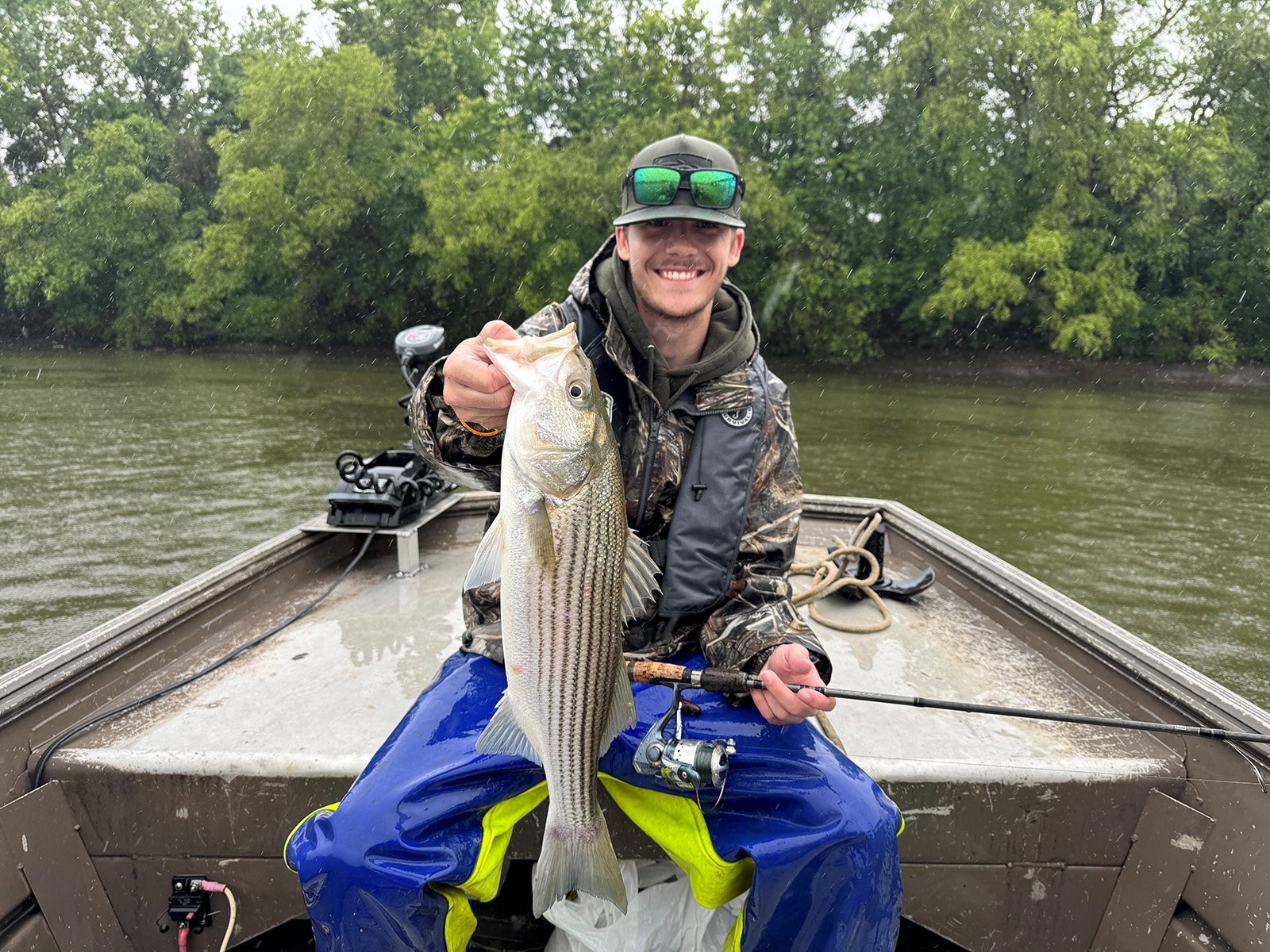
Fish Bite in the Rain!
By Hunter Campbell/DWR
Photos by Alex McCrickard/DWR
Fishing in the rain may not sound ideal to most people, however many anglers know that wet weather can provide some of the best fishing opportunities. Rainy conditions can trigger changes in fish behavior, often making them more active and willing to bite. One of the key factors influencing this behavior is barometric pressure, which shifts before, during, and after a storm.
Understanding how rain and pressure changes affect fish movement and feeding patterns can give anglers a major advantage. With the right gear, safety precautions, and a bit of knowledge, fishing in the rain can turn a dreary day into one of the most productive on the water!
“My most productive days are always when the weather is wet and dreary,” Dr. Michael Bednarski, DWR’s chief of fisheries and noted bass fishing fanatic. “I’ve had some monster days throwing a buzzbait or a crawler in the pouring rain, and my personal best Virginia bass—a 7.57-pound largemouth from Lake Chesdin—ate a jerkbait on a rainy January morning.”
Barometric Pressure and Fish Behavior
Anglers often look to fish during periods while the barometer is dropping, which can trigger a short window of aggressive feeding. Many anglers report increased fish activity right before a weather front moves in. Fish often sense that a storm is approaching and will feed heavily while conditions are still manageable.
Fishing During the Rain
Fishing during light to moderate rain has several benefits. First, the rain breaks up the surface of the water, making it harder for fish to see anglers, lures, and boats. This allows for a more natural presentation of lures. Rain also cools the water temperature slightly and increases oxygen levels, which can energize fish and encourage feeding.
In addition, rain runoff can wash insects, worms, and other food sources into lakes, rivers, or ponds. This influx of natural bait often draws fish to mouths of creeks, culverts, or shallow banks where food collects. Targeting these areas can be very productive.
What Tackle to Use
When fishing in the rain, it’s important to adjust your tackle to match the changing conditions. Rain reduces visibility in the water, so using lures that create vibration can be very productive. Spinnerbaits, chatter baits, and square bill crankbaits can help attract fish in these conditions. Darker colors such as black, Junebug, or chartreuse work best in overcast conditions or stained water because they provide a higher contrast.
Heavier weights are also useful in rainy conditions to maintain better control of your bait, especially in areas with increased current or runoff. Additionally, using strong, abrasion-resistant line like fluorocarbon or braided line ensures that your setup holds up against debris and submerged cover. By matching your tackle to the environment, you can take full advantage of the feeding opportunities that rain often brings.

Maintaining Safety
Fishing in the rain can be rewarding, but it also comes with important safety concerns that anglers should not overlook. Wet conditions increase the risk of slipping on rocks, muddy banks, or boat decks, so wearing non-slip, waterproof footwear is essential. As always, make sure you’re wearing a life jacket when aboard a boat or paddlecraft.
Lightning is the most serious danger—if you hear thunder or see lightning, you should immediately stop fishing and seek shelter, as water is a powerful conductor of electricity. Cold rain and wind can also lead to hypothermia, especially if you’re not dressed in proper waterproof and insulated clothing.
Additionally, heavy rainfall can raise water levels quickly, creating strong currents and hazardous conditions in rivers and streams. Always check the weather forecast before heading out and let someone know your plans in case of emergency. Being prepared and cautious can help ensure your rainy-day trip remains both productive and safe!
Final Thoughts
While fishing in the rain requires proper gear and a willingness to get wet, the rewards can be well worth it. By understanding how barometric pressure influences fish behavior and combining that knowledge with smart lure selection and positioning, anglers can turn stormy weather into a winning opportunity. Whether you’re chasing bass in a pond or trout in a stream, the next time clouds roll in—don’t pack up. Cast a line!
Hunter Campbell is working as an intern in DWR’s Outreach department for the summer of 2025.
Distribution channels:
Legal Disclaimer:
EIN Presswire provides this news content "as is" without warranty of any kind. We do not accept any responsibility or liability for the accuracy, content, images, videos, licenses, completeness, legality, or reliability of the information contained in this article. If you have any complaints or copyright issues related to this article, kindly contact the author above.
Submit your press release